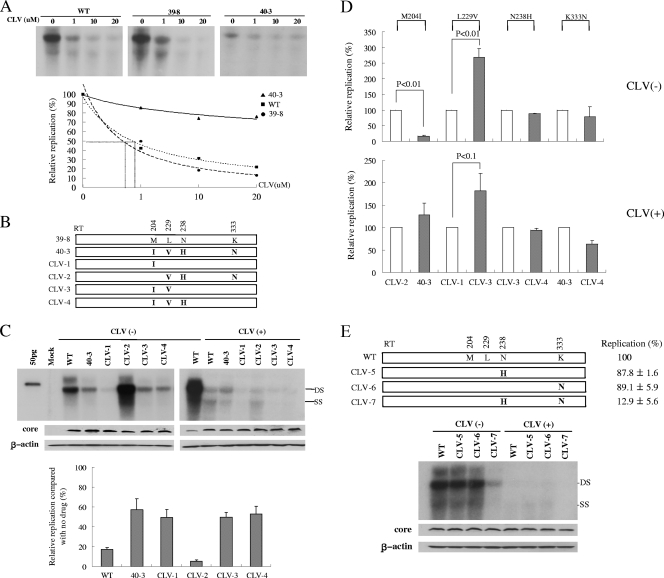FIG. 3.
Characterization of RT mutations associated with viral BT during CLV treatment. (A) IC50s for the WT and mutant HBV clones. A CLV susceptibility assay was performed after the transfection of 2 μg of the HBV1.2mers into Huh7 cells following Southern blot analysis. The replicative ability of each mutant was quantified using a phosphorimager; the amount of replication without drug treatment was set at 100%. The IC50s were obtained by interpolation of the data. (B) Schematic representation of the mutant constructs. Clone 39-8 has WT residues at positions 204, 229, 238, and 333, as shown in Table 1. Each residue that differs from that in the WT sequence is shown. (C) Functional characterization of each conserved mutation in terms of replicative ability and susceptibility to CLV. Each value obtained by phosphorimager analysis was divided by the WT value [CLV(−)] on the same blot to normalize the intensity. The levels of replication without CLV treatment were set at 100% for each clone, and the relative amount of replication in the presence of CLV was calculated. Western blotting was performed with polyclonal anti-core antibodies; after stripping, the membrane was reblotted with anti-β-actin antibodies. (D) Relative replication of the mutant clones with or without CLV treatment. Empty bars represent the WT sequence at the indicated positions, whereas dotted bars indicate a point mutation, as shown in the upper part of the panel. Replication of the WT sequence at the indicated position (empty bars) was set at 100%, and the relative replication of the point mutants (dotted bars) was calculated. The graph includes data from at least three independent Southern blots with or without CLV treatment; each part of the panel shows data from a representative autoradiogram. (E) Schematic representation of the mutant constructs and their effects on genome replication and CLV susceptibility. Values represent the mean of at least three independent experiments. DS, double strand; SS, single strand.

